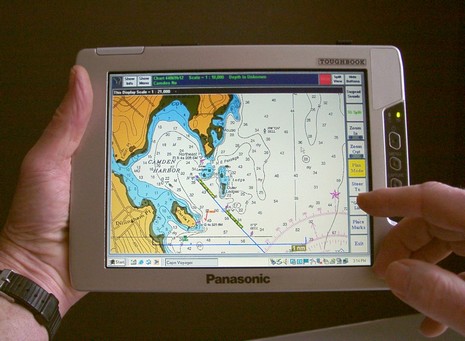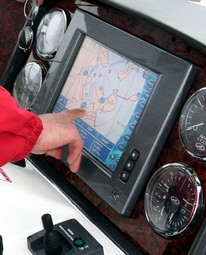“Touchscreen”, mind the meanings!

That’s a Panasonic Toughbook MDWD I tested for PMY back in early 2003, and mentioned here when Nobeltec began selling it as a navigation accessory. It came with a simple plastic stylus—nice for, say, setting a waypoint bang on a buoy—but it could also be fingered. Check the larger shot and see how easy it was to tap common underway controls like zooming using those big buttons in Capn Voyager (or in Nobeltec Admiral’s NavView). Well, I’m a bit shocked to discover that the current model of Panasonic’s wireless display seems to use an active digitizer stylus, and will not respond to a finger.
I say “seems” because isn’t clear even in the unit’s manual if you have to use the stylus. But then again the same Panasonic site touts this Toughbook-19 for having a “pressure-sensitive touchscreen” which “can be used with a stylus or the touch of a finger.” So both products are described as “touchscreen” but deeper down one turns out to be uniquely “pressure-sensitive touchscreen?” That’s confusing!
Now, as mentioned yesterday, I think an active digitizer is great for a lot of tasks,  but if you want to use a PC charting program like a plotter mounted by your helm, you do not want to pick up a stylus just to zoom a chart. Actually that’s a weak analogy as I think a really good finger-touch-control charting device—like a Garmin 5212, or a Maptech i3–can be easier to use than any conventional plotter (at least until it gets really rough). That’s why I’m excited about yesterday’s HP TouchSmart and the fact that some tablet PCs are getting an alternate finger interface (which I hear Captn Jack will adopt once the feature is combined with an extra bright screen). I just wish the manufacturers would clarify “touchscreen” terminology.
but if you want to use a PC charting program like a plotter mounted by your helm, you do not want to pick up a stylus just to zoom a chart. Actually that’s a weak analogy as I think a really good finger-touch-control charting device—like a Garmin 5212, or a Maptech i3–can be easier to use than any conventional plotter (at least until it gets really rough). That’s why I’m excited about yesterday’s HP TouchSmart and the fact that some tablet PCs are getting an alternate finger interface (which I hear Captn Jack will adopt once the feature is combined with an extra bright screen). I just wish the manufacturers would clarify “touchscreen” terminology.













On a stable platform a touch screen might work fine. But on a boat which is pitching about I don’t know how you can use a finger or a stylus to high some point/command. I have a hard enough time using a PDA touch screen with a stylus or a finger in an Audi!… can’t even imagine this interface in a powerboat slamming over waves or a pitching sailboat.
Am I nuts or are they?
The idea of toughscreen with not responding to just pressure is easily explained. The way we use the panasonic touchscreen while racing is that we have it in transparent waterproof plastic bag somewhere on the deck.
All the spray and other unintentional pressure to touch screen results in faulty signals. In that kind of environment I do understand the idea of making the stylus required to affect the screen.
It is actually easier to operate when you have the screen in your hands (hand) and you operate with the other hand in relation to situation where the touchscreen would be secured to the boat (eg a fixed plotter)